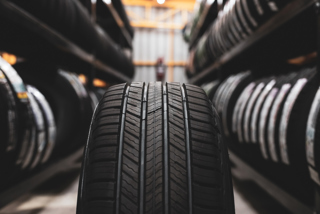Police fleets are increasingly adopting telematics to cut costs in the face of austerity. Andrew Ryan asks two police fleet operators how the technology has helped them

Graham Crow, head of transport and travel, Northamptonshire Police
Fleet size: 420
No of vehicles with telematics: 370
Steve Thompson, head of transport, West Yorkshire Police
Fleet size: 1,000
No of vehicles with telematics: 550
When and why did you introduce telematics?
Graham Crow: We have a fleet of 420 vehicles and we finished putting telematics into 370 cars in October 2013. The original concept was to improve driver behaviour, vehicle utilisation, make cost savings and potentially be able to carry out dispatch and also some police investigation through IDR (incident data recording). We had to make an initial investment of £350,000 but we made that back in a very short space of time. Our figures from April 2016 show that we are doing nearly 900,000 miles fewer than our baseline figure in 2013, and we have reduced our annual fuel use from about 16,000 gallons to 11,600.
Our original aim was to reduce fuel use by 9%, and we’ve managed to reach 27%. So I’ve been able to reduce my fuel budget year-on-year and we’ve been able to return money to the centre. For our cars fitted with CAN (bus) – which is quite a substantial part of the fleet – we are seeing a 13% improvement in fuel economy. It may seem strange having a target for incidents a year, but we aim for something like 210 collisions, which includes dinking a wheel right through to a collision with another car – they are all counted the same. We were always above that 210, but we went right down to 169 before last year when we crept up to about 185.
That is still 12% below our target, so we are reducing collisions through better driver behaviour, maybe by not going as fast and being a bit more cautious going into a car park bay: just taking that bit of extra care.
Steve Thompson: We’ve had telematics in our cars for more than seven years and one of our main focuses when we took on the technology was to reduce the amount of collisions we had and their associated costs. We managed to cut our incident rate by 34% and are maintaining that level of collisions.
That is still a big focus, but we have now set up a driver standards board across the force where we have a look at all incidents that have happened in the period leading up to the board meeting. At the same time, we view the telematics data from the vehicles and then make decisions around whether we look at driver training or any other actions that the force feels it needs to take.
How has your use of telematics developed since then?
Steve Thompson: One of the big changes we’ve made in the past couple of years is that we now use telematics to concentrate on vehicle utilisation. We have geofences set up all around our police station and we can now see how the vehicles are being used. That has allowed us to revisit how many vehicles we keep on the fleet. In 2011/2012 we did 19.67 million miles: in the past four years the use of telematics has contributed to us being able to reduce this by more than 2.3 million annually. During the same time we have seen an improvement in our actual vehicle fuel economy, which is now averaging 35.7mpg from the 30mpg recorded in 2012. We originally started with a fleet of 1,200, now for the first time we’ve dipped under 1,000 vehicles so we are getting better utilisation out of the existing fleet, which is saving us a lot of money.
Do you use telematics for officer deployment?
Graham Crow: No, but the system that we employ is also used by Norfolk and Suffolk Police which does use it for deployment. We are now looking at something called ‘saas’ (software as a service) and using the telematics as a sat-nav. That means our provider hosts, through a third-party secure site, our data so our IT department doesn’t have to worry – apart from the policing of it. The control room will be able to see the cars on a map and will be able to send a message through that goes straight on to a vehicle’s sat-nav and that system will then plot the officers’ route. That’s not in yet, but we are working towards that now.
Steve Thompson: As a force we took the decision not to use the telematics as a deployment tool, as we have another system in place which is used for this.
What other benefits have you found?
Graham Crow: Our other really big saving is that previously, if we had a notice of intended prosecution for a speeding or parking offence come in, that could potentially take weeks or months to identify who was driving the car at that particular time. Our drivers use their ID cards or warrant cards to log in to a car and, providing it’s one of our 370 vehicles with telematics, we can now input its registration number on a date/time report and it comes up with who the driver was, what speed they were doing and whether it was on a bluelight run. We can then process that very quickly and if someone has been speeding they get taken to task. But if it’s a marked car with its blue lights on, then that can be pinned down and sorted very quickly. What used to take hours of work we can now probably resolve in 20 minutes.
Steve Thompson: Drivers have to swipe into the vehicles using their police ID card, so we always know who is driving the vehicle: if you don’t swipe in, the vehicle does not start. If we get any speeding offences through traffic cameras that are deemed not a police operational job, the driver of the vehicle is easily located and they end up with the penalty points and fine.
What advice would you have for other police fleet managers considering adopting telematics?
Graham Crow: The one area where we haven’t done so well, which is a caution to anybody adopting telematics, is that there is a lot of data and you need somebody, especially in the early stages, to dig into the data, look at it, determine what it’s telling you and come up with some recommendations. Some of it can be done through reports, but if you’ve got a data analyst then they can look at what the information is and interpret what they are seeing.
Chiltern Transport Consortium (which attends to the fleet requirements of Thames Valley Police, Bedfordshire Police, Civil Nuclear Constabulary and Hertfordshire Constabulary) has employed a data analyst right from the outset to reap the best benefit from the data provided by its telematics system.
There is so much data to get stuck into and if you are trying to improve utilisation, for instance, you want somebody away from this desk able to look at it and come up with some assumptions. You can go and challenge that and then remove cars, hold them back in pool, and if you find they haven’t got enough you can feed them back. If you have got enough cars then you can feed them to another team that hasn’t got enough vehicles, or you can reduce your fleet size if it turns out you have got too many.





















Login to comment
Comments
No comments have been made yet.